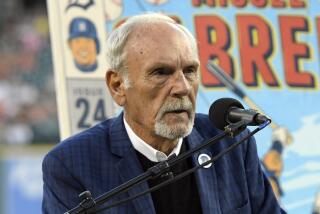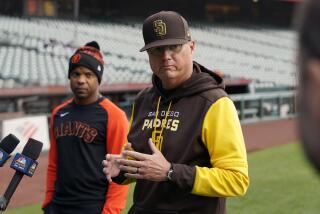Thrift Goes to Speed to Rebuild the Pirates
- Share via
PITTSBURGH — Syd Thrift has a reputation as a slow-walking, slow-talking procrastinator who acts only after laborious deliberation. So his overhaul of the Pittsburgh Pirates in just 18 months as general manager has surprised many.
A former scout and real estate salesman who had been out of organized baseball for 10 years until his return to Pittsburgh’s front office in November 1985, Thrift has:
--Molded the Pirates in in his own image of a good team: young pitchers with strong arms, good defense with speed and consistent if not power-laden hitting.
--Traded away, sold or released all but three of the players from the 1984 Pirates, which began the franchise’s current string of three consecutive NL East last-place finishes.
--Hired an intense, competitive manager, Jim Leyland, who has won praise from his players and fellow managers for his deft handling of a youthful roster.
--Relied on unusual baseball training aids such as holding pre-spring training for young players, hiring a visualization specialist and promoting time-measured leads for baserunners.
--Made a point of acquiring only players who have expressed a willingness to play in Pittsburgh, a city whose dwindling support of the Pirates nearly caused the team to leave town in 1985.
--Emphasized the desire to build from within the organization, unlike former General Manager Pete Peterson’s increasing reliance on trades and free agent signings.
--Lived up to his name by slicing the Pirates’ payroll to such a degree that the team will play former players such as Steve Kemp, Larry McWilliams and Lee Mazzilli nearly as much money this year as it will its current roster.
“I didn’t expect to have to make as many changes as we have,” said Thrift. “When I came here, I came here with an open mind. I was willing to give everybody a chance. Everything we have done has been in the best interests of the Pittsburgh Pirates . . . to have a more competitive club.”
“I think we both were surprised things were as bad as they were when we got here,” Leyland said.
Thrift has predicted that by 1989, the Pirates would be ready to challenge for a division title. If their play so far this season is an accurate barometer--they are flirting with the .500 mark for the first time since 1983--the Pirates are on schedule, especially considering they lost 104 games in 1985 and 98 in 1986.
The Pirates’ young pitching staff has had plenty of problems, but recent additions such as Barry Bonds, Sid Bream and R.J. Reynolds (holdovers from Joe L. Brown’s brief return as interim general manager), Mike Diaz and Mike LaValliere have made solid contributions.
“I haven’t been working 16 hours a day since I got here and Jim Leyland hasn’t been working 16 hours a day since he got here for us to remain mediocre,” Thrift said.
The proverbial jury remains out on Thrift, whose two-year contract expires at the end of this season. Last month’s trading away of popular All-Star catcher Tony Pena disappointed many fans, and Three Rivers Stadium attendance is down 14% this season despite the team’s improved play.
“He’ll be remembered either as the great experiment that failed--the real estate man turned baseball executive--or the greatest innovater since Branch Rickey,” said Pittsburgh sportscaster Myron Cope.
“You can look at nearly every position on the field and see that we are a better ballclub than we were” when he took charge, Thrift said. “I think the players have responded to what we’ve tried to do. They’re happy to be playing for the Pirates.”
Their clubhouse may not have the nightclub-like frivolity of the “We-Are-Family” Pirates, but the attitude is considerly more cheerful and upbeat than the malcontent days of John Candelaria and George Hendrick.
“We’ve got guys who battle and guys who can win,” said pitcher Brian Fisher, acquired in a winter deal with the New York Yankees. “I’m enjoying myself here . . . I think everybody is enjoying themselves here.”
More to Read
Go beyond the scoreboard
Get the latest on L.A.'s teams in the daily Sports Report newsletter.
You may occasionally receive promotional content from the Los Angeles Times.










